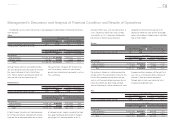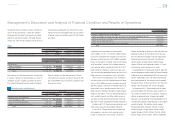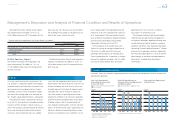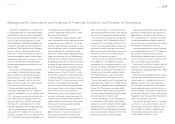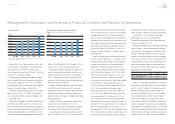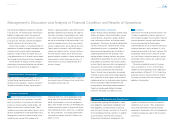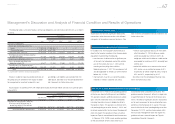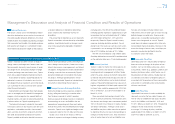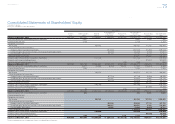Toyota 2013 Annual Report Download - page 66
Download and view the complete annual report
Please find page 66 of the 2013 Toyota annual report below. You can navigate through the pages in the report by either clicking on the pages listed below, or by using the keyword search tool below to find specific information within the annual report.
Toyota Global Vision President’s Message Launching a New Structure Special Feature Review of Operations
Consolidated Performance
Highlights
Management and
Corporate Information Investor InformationFinancial Section
Page 66
NextPrev
ContentsSearchPrint
ANNUAL REPORT 2013
Credit Facilities with Dealers
Toyota’s fi nancial services operations maintain credit
facilities with dealers. These credit facilities may be
used for business acquisitions, facilities refurbish-
ment, real estate purchases, and working capital
requirements. These loans are typically collateralized
with liens on real estate, vehicle inventory, and/or
other dealership assets, as appropriate. Toyota
obtains a personal guarantee from the dealer or
corporate guarantee from the dealership when
deemed prudent. Although the loans are typically
collateralized or guaranteed, the value of the under-
lying collateral or guarantees may not be suffi cient
to cover Toyota’s exposure under such agreements.
Toyota prices the credit facilities according to the
risks assumed in entering into the credit facility.
Toyota’s fi nancial services operations also provide
fi nancing to various multi-franchise dealer organiza-
tions, referred to as dealer groups, often as part of
a lending consortium, for wholesale inventory fi nancing,
business acquisitions, facilities refurbishment, real
estate purchases, and working capital requirements.
Toyota’s outstanding credit facilities with dealers
totaled ¥1,795.8 billion as of March 31, 2013.
Guarantees
Toyota enters into certain guarantee contracts with
its dealers to guarantee customers’ payments of
their installment payables that arise from installment
contracts between customers and Toyota dealers,
as and when requested by Toyota dealers.
Guarantee periods are set to match the maturity of
installment payments, and as of March 31, 2013,
ranged from one month to 35 years. However, they
are generally shorter than the useful lives of prod-
ucts sold. Toyota is required to execute its guaran-
tee primarily when customers are unable to make
required payments.
The maximum potential amount of future pay-
ments as of March 31, 2013 is ¥1,849.4 billion.
Liabilities for these guarantees of ¥6.5 billion have
been provided as of March 31, 2013. Under these
guarantee contracts, Toyota is entitled to recover
any amounts paid by it from the customers whose
obligations it guaranteed.
Toyota uses its securitization program as part of its
funding through special purpose entities for its
fi nancial services operations. Toyota is considered
the primary benefi ciary of these special purpose
entities and therefore consolidates them. Toyota has
not entered into any off-balance sheet securitization
transactions during fi scal 2013.
Off-Balance Sheet Arrangements
Credit Facilities with Credit Card Holders
Toyota’s fi nancial services operations issue credit
cards to customers. As customary for credit card
businesses, Toyota maintains credit facilities with
holders of credit cards issued by Toyota. These
facilities are used upon each holder’s requests up to
the limits established on an individual holder’s basis.
Although loans made to customers through these
facilities are not secured, for the purposes of
Lending Commitments
minimizing credit risks and of appropriately estab-
lishing credit limits for each individual credit card
holder, Toyota employs its own risk management
policy which includes an analysis of information pro-
vided by fi nancial institutions in alliance with Toyota.
Toyota periodically reviews and revises, as appropri-
ate, these credit limits. Outstanding credit facilities
with credit card holders were ¥245.2 billion as of
March 31, 2013.
For information regarding debt obligations, capital
lease obligations, operating lease obligations and
other obligations, including amounts maturing in
each of the next fi ve years, see notes 13, 22 and 23
to the consolidated fi nancial statements. In addition,
as part of Toyota’s normal business practices,
Toyota enters into long-term arrangements with
suppliers for purchases of certain raw materials,
components and services. These arrangements
may contain fi xed/minimum quantity purchase
requirements. Toyota enters into such arrangements
to facilitate an adequate supply of these materials
and services.
Contractual Obligations and Commitments
Management’s Discussion and Analysis of Financial Condition and Results of Operations
pension benefi t obligations resulted from a decline
in discount rate. On the other hand, the increase in
liabilities of foreign plans refl ects the increase in
pension benefi t obligations resulted from a decline
in discount rate. See note 19 to the consolidated
fi nancial statements for further discussion.
Toyota’s treasury policy is to maintain controls on
all exposures, to adhere to stringent counterparty credit
standards, and to actively monitor marketplace
exposures. Toyota remains centralized, and is pur-
suing global effi ciency of its fi nancial services opera-
tions through Toyota Financial Services Corporation.
The key element of Toyota’s fi nancial strategy is
maintaining a strong fi nancial position that will allow
Toyota to fund its research and development
initiatives, capital expenditures and fi nancial services
operations effi ciently even if earnings are subject to
short-term fl uctuations. Toyota believes that it main-
tains suffi cient liquidity for its present requirements
and that by maintaining its high credit ratings, it will
continue to be able to access funds from external
sources in large amounts and at relatively low costs.
Toyota’s ability to maintain its high credit ratings is
subject to a number of factors, some of which are
not within Toyota’s control. These factors include
general economic conditions in Japan and the other
major markets in which Toyota does business, as
well as Toyota’s successful implementation of its
business strategy.
Selected Financial Summary (U.S. GAAP) Consolidated Segment Information Consolidated Quarterly Financial Summary Management’s Discussion and Analysis of Financial Condition and Results of Operations [21 of 26] Consolidated Financial Statements Notes to Consolidated Financial Statements
Management’s Annual Report on Internal Control over Financial Reporting Report of Independent Registered Public Accounting Firm




